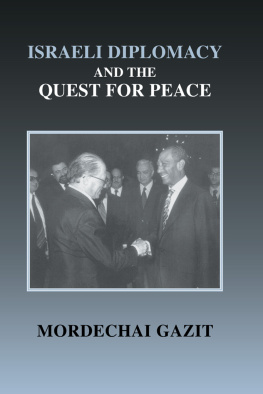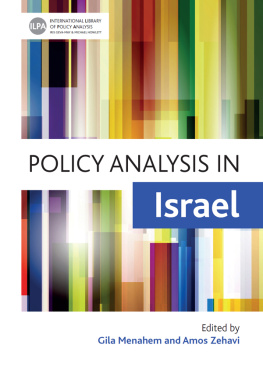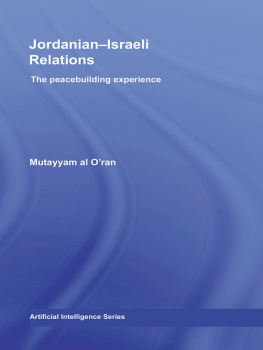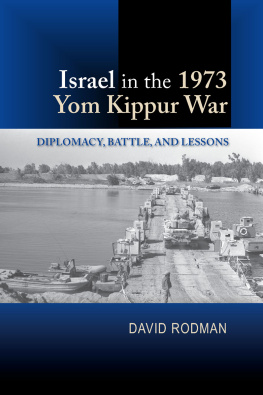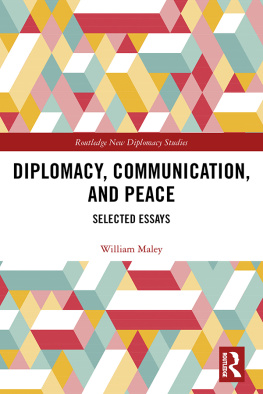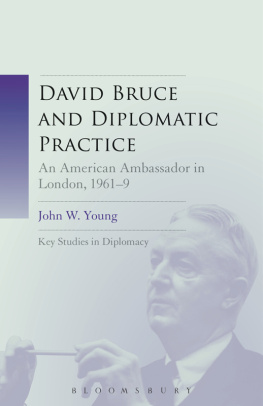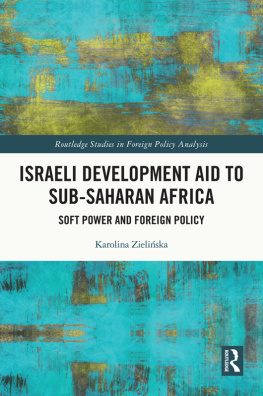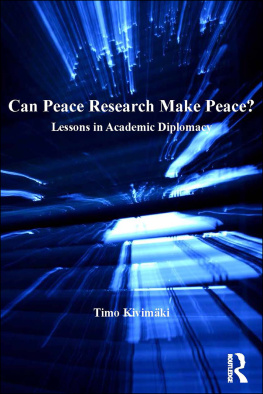ISRAELI DIPLOMACY AND THE QUEST FOR PEACE

First published in 2002 in Great Britain by
Routledge
2 Park Square, Milton Park,
Abingdon, Oxon, OX 14 4RN
and in the United States of America by
Routledge
270 Madison Ave, New York NY 10016
Transferred to Digital Printing 2007
Website: www.routledge.com
Copyright 2002 M. Gazit
British Library Cataloguing in Publication Data
Gazit, Mordechai
Israeli diplomacy and the quest for peace. (Israeli
history, politics and society)
1. Arab-Israeli conflict 1993 Peace 2. Israel Foreign
relations United States 3. United States Foreign
relations Israel
I. Title
327.5694
ISBN 0-7146-5233-4
ISSN 1368-4795
ISBN 978-1-1352-8581-4 (epub)
Library of Congress Cataloging-in-Publication Data
A catalog record for this book is available
from the Library of Congress
2001032310
All rights reserved. No part of this publication may be reproduced, stored in or introduced into a retrieval system or transmitted in any form or by any means, electronic, mechanical, photocopying, recording or otherwise, without the prior written permission of the publisher ofthis book.
Typeset in Baskerville 11 on 13pt by FiSH Books, London WC1
Cover illustration: Anwar Sadat and Menachim
Begin meet in 1978.
Publishers Note
The publisher has gone to great lengths to ensure the quality of this reprint
but points out that some imperfections in the original may be apparent
I AM GREATLY indebted to the Harry S. Truman Research Institute for the Advancement of Peace, Hebrew University of Jerusalem, without whose help, counsel and support this collection would not have been possible.
| AWACS | Airborne Warning and Control System Surveillance Aircraft |
| CAB | Cabinet Paper |
| FRUS | Foreign Relations of the United States |
| GA | United Nations General Assembly |
| HMG | His/Her Majestys Government the government of the UK |
| IDF | Israel Defence Forces |
| IDP | International Documents on Palestine |
| ISA | Israel State Archives |
| LEHY | Lohamei Herut Yisrael Freedom Fighters of Israel |
| MENA | Middle East News Agency |
| PCC | Palestine Conciliation Commission (of the United Nations), also called the Conciliation Commission for Palestine (CCP) |
| PLO | Palestinian Liberation Organization |
| PRO | Public Record Office |
| UNEF | United Nations Emergency Force |
Pages 176 and 177
1. Israel and Jordan sign peace treaty at Arava border crossing (16 October 1994). From left to right: Yitzhak Rabin, President Bill Clinton and King Hussein.
2. The first Arab-Israeli peace. President Anwar Sadat, President Jimmy Carter and Menachem Begin at Camp David, Maryland, USA (September 1978).
3. A historic visit. Anwar Sadat in Jerusalem, Israel (November 1977) flanked by Golda Meir and Shimon Peres.
4. Anwar Sadat and Menachem Begin meet in 1978.
T HIS BOOK is a collection of twelve articles written between 1981 and 1999. Where necessary, the articles have been updated. Changes have been made in most of them and some have been expanded.
Broadly speaking, the case studies published here focus on three themes of crucial importance to a student of Middle East peace efforts since 1948. Third-party involvement, or mediation as it is usually though not altogether accurately, called was for a very long time the only technique available in attempting to establish a link of communication, be it tenuous and indirect, between the Arabs and Israel. It was hoped that by such means differences would be narrowed and tensions reduced. This is the first basic theme dealt with in the book. The second theme is the Israeli elites attitude to the question of whether Israel has missed opportunities to advance peace. The third theme concerns Israels relations with the United States. This relationship has been of enormous importance and continues to be so. It was vital to Israel in the early days of the state, when American support was small and not always unambiguous. The relationship assumed its present form and magnitude about 30 years ago.
The impact of the United States on Middle East peace efforts has been decisive especially when the United States involved itself fully, less so in the first two decades (1948-71), when it chose to act through the UN. At times, as is recounted in America and Israel A Special Relationship Not Always Special, Israel had cause to be wary of US peace initiatives: and yet US-Israel relations remain quite unique. The reasons for this extraordinary phenomenon have been summarized by a former US ambassador to Israel, Samuel W. Lewis. He postulates that several elements, all of them psychological, combined to lay the foundation for this relationship:
The first of these was guilt, guilt about the Nazi holocaust...while America turned a blind eye far too long. That sense of guilt reinforced [a second element,] a general American humanitarian impulse toward helping arrange the resettlement of throngs of [Jewish] refugees displaced from the ruins of Hitlers Europe...The third influential element was politics, the influence of Jewish donors and voters in American political life... Idealism contributed admiration for the founding of a new democratic state... Religious identification with a common Judeo-Christian Bible and heritage fired the enthusiasm of many American Christians for this return to the Biblical Holy Land by an ancient nation of wanderers... Only much later...was added: a so-called strategic relationship... eventually ripening... into todays virtual military alliance.
The present close cooperation in the field of defence between the two countries started in the 1960s. President Kennedy should be given more credit for what he did in this matter, even if he appeared to do it somewhat casually. President Johnson after him added another layer (see The Genesis of the US-Israel Military-Strategic Relationship and the Dimona Issue) thereby giving notice that the United States would continue on the course just started.
US economic and military aid has reached by now a total of $75 billion. In real terms the value of this sum is considerably higher than the nominal figure, if one allows for the devaluation of the dollar over the 30-year period.
In the last 15 years all US military assistance to Israel has been in the form of grants. Still, as pointed out in Israeli Military Procurement from the United States, military assistance constitutes at present two per cent of Israels Gross Domestic Product (GDP), while when it started it was over five per cent.
US aid has not only been a boon to Israels economy but, no less important, it has made US arms and military technology accessible to Israel. During the first years of its existence as a state Israel had no assured source from which it could procure the arms it needed. The accessibility of the French arms industry was a timely solution that lasted over a decade until it was brought to an end by De Gaulles embargo on military sales to Israel in 1967. Since 1947, Israel has experienced various embargoes and suspensions of deliveries, including several from the United States. This has led it to conclude that it must not be wholly dependent on foreign sources, even the friendliest, including the United States. The evident answer was to develop local arms and aircraft industries. This too was achieved in cooperation with the United States, benefiting both in the process.

